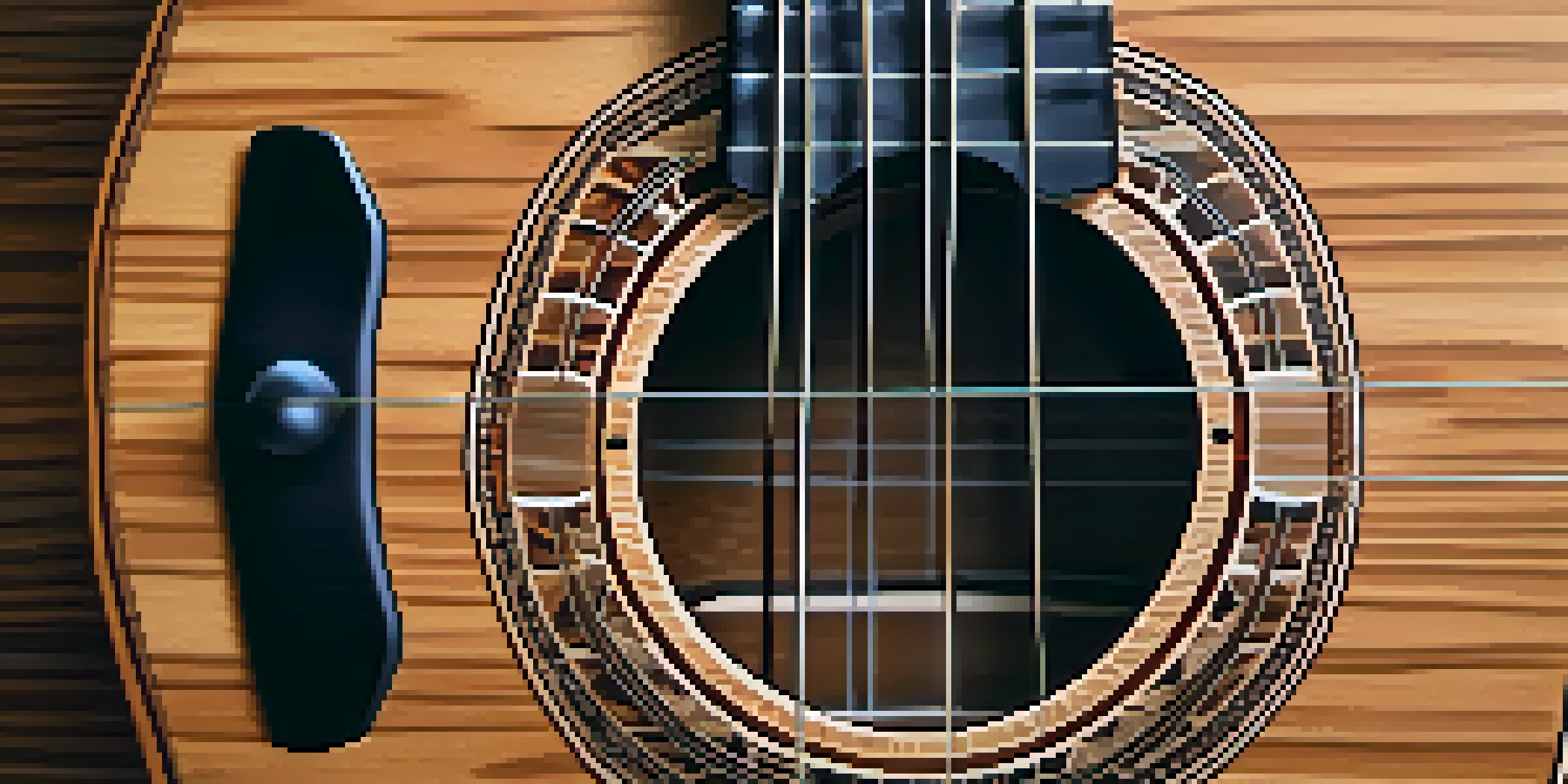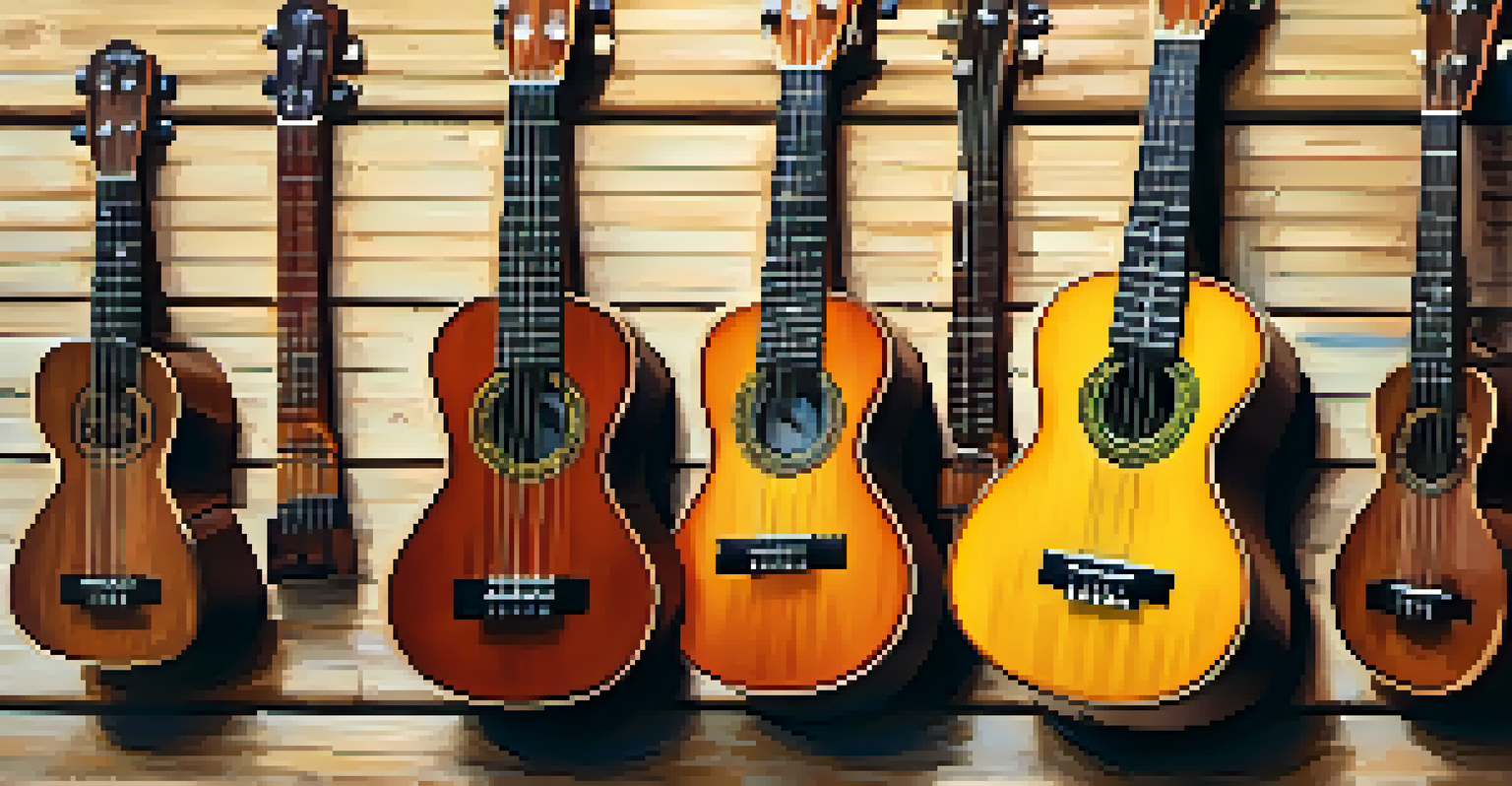Acoustic Design: How Bracing Patterns Affect Ukulele Sound

The Importance of Acoustic Design in Ukuleles
Acoustic design plays a crucial role in shaping the sound of any string instrument, including the ukulele. The way a ukulele is constructed, particularly its internal bracing, has a direct impact on its tonal quality and resonance. Understanding this importance helps musicians make informed choices when selecting or crafting their instruments.
The sound of a ukulele is a reflection of its construction; every brace tells a story.
Bracing refers to the wooden support structures inside the ukulele's body that help it withstand the tension of the strings while enhancing sound production. Different bracing patterns can significantly alter how sound waves travel through the instrument, affecting volume, sustain, and overall tone. This means that even small changes in design can lead to vastly different musical experiences.
As we delve into the world of ukulele bracing, we'll explore various patterns and their specific effects on sound. By the end, you'll have a clearer understanding of how these design choices influence your favorite ukulele's voice.
What is Bracing in Ukuleles?
Bracing in a ukulele consists of strategically placed wooden strips inside the body that strengthen it and influence its acoustics. These braces help distribute the tension from the strings evenly across the instrument, preventing warping while allowing for optimal sound projection. Different types of bracing can create unique tonal characteristics.

For instance, traditional fan bracing involves several thin strips radiating from the soundhole, resembling a fan. This pattern enhances the instrument's volume and gives it a bright, clear tone. On the other hand, ladder bracing features horizontal braces, which can produce a warmer, more mellow sound, making the ukulele feel more resonant.
Bracing Shapes Ukulele Sound
The internal bracing pattern directly influences a ukulele's tonal quality, volume, and resonance.
Ultimately, the choice of bracing pattern impacts not only the durability of the ukulele but also how it interacts with the player's style. Understanding these differences can help players choose an instrument that fits their musical preferences.
Common Bracing Patterns and Their Effects
There are several common bracing patterns used in ukulele construction, each offering distinct sound qualities. The most prevalent include fan bracing, ladder bracing, and X-bracing. Each pattern influences the way vibrations travel through the instrument, resulting in different tonal characteristics.
In music, the instrument is as important as the musician; the bracing shapes the voice that you bring to life.
Fan bracing, as mentioned earlier, provides a bright and powerful sound, making it popular among players who seek projection and clarity. Ladder bracing, while offering a softer tone, can provide excellent sustain, which many musicians appreciate for strumming styles. X-bracing, often used in guitars, is less common in ukuleles but can produce a rich, balanced tone.
Understanding these patterns can help players make informed decisions when selecting a ukulele. If you're after a specific sound, knowing what bracing patterns to look for is an essential step in your journey.
How Bracing Affects Volume and Projection
One of the primary functions of bracing is to influence the volume and projection of a ukulele. The arrangement and thickness of the braces can either enhance or dampen the sound waves produced by the instrument. This means that two ukuleles with the same body shape can sound dramatically different based on their bracing.
For example, a ukulele with more robust bracing may produce a louder sound, making it suitable for performance settings. Conversely, a lightly braced ukulele may have a softer sound, which can be ideal for intimate settings or recording. The key is to find the right balance that suits your playing style and environment.
Choose Bracing for Your Style
Selecting the right bracing pattern based on your playing style can enhance your musical experience.
In essence, bracing affects how well the sound resonates within the body of the ukulele and how it projects outward. This knowledge can guide players in selecting ukuleles that align with their performance needs.
The Impact of Bracing on Tone Quality
Tone quality is subjective and varies from player to player, but bracing undeniably shapes it. The material, thickness, and pattern of the braces influence how the instrument responds to playing styles and techniques. This means that a ukulele's voice can be quite unique based on its bracing.
For instance, an instrument with fan bracing might deliver a bright, punchy tone perfect for fingerpicking, while ladder-braced ukuleles may lean toward a warmer sound that complements strumming. Understanding these tonal differences allows musicians to choose the right instrument for their individual sound preferences.
Ultimately, the relationship between bracing and tone quality can transform how you experience playing the ukulele. A deeper understanding of this connection can help you select an instrument that resonates with your musical identity.
Choosing the Right Bracing for Your Playing Style
When selecting a ukulele, considering your playing style is essential in choosing the right bracing pattern. If you primarily strum chords, you might prefer a ukulele with a more robust bracing system that offers volume and clarity. On the other hand, if you enjoy fingerpicking, a lighter bracing pattern could yield the nuanced sound you're after.
It’s also helpful to experiment with different bracing patterns to find what resonates with you. Many music stores allow you to try out various instruments, giving you a chance to hear firsthand how bracing affects sound. Listening to different ukuleles will help you understand how bracing aligns with your musical preferences.
Common Bracing Patterns Explained
Understanding different bracing types like fan, ladder, and X-bracing helps musicians make informed choices.
Ultimately, taking the time to consider how bracing impacts your playing can lead to a more fulfilling musical experience. The right ukulele can inspire creativity and enhance your overall enjoyment.
Conclusion: Embracing the Science of Ukulele Sound
Understanding how bracing patterns affect ukulele sound is key to making informed choices in your musical journey. The interplay between bracing and sound quality, volume, and tonal characteristics can help you select an instrument that truly resonates with you. Whether you prefer bright, loud tones or warm, mellow sounds, there's a ukulele out there that can meet your needs.
As you explore different ukuleles, keep in mind how bracing impacts not just the instrument's sound but also your playing style. By embracing the science behind acoustic design, you can deepen your appreciation for this delightful instrument.

In your quest for the perfect ukulele, remember that knowledge is power. The more you understand about how bracing patterns influence sound, the better equipped you'll be to choose an instrument that enhances your unique musical expression.